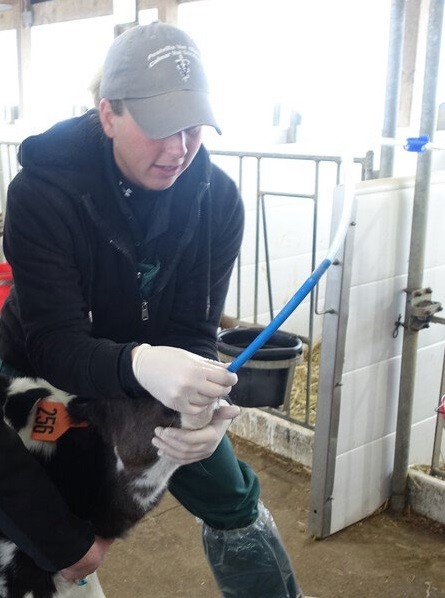Calf Tube Feeding Protocol
Alycia Drwencke, Dairy Management Specialist
Southwest New York Dairy, Livestock and Field Crops Program
Calf Tube Feeding Done Right by Maureen Hanson

An esophageal tube feeder can be a lifeline for young calves, delivering colostrum, milk or electrolytes when they are unable to suckle a bottle. But incorrect use of these feeders can be dangerous or even deadly. The University of Wisconsin Dairy Extension team shares advice on the best methods for using tube feeders. (Maureen Hanson)
Colostrum, milk and electrolytes all can be vital to calf survival, and may need to be delivered via an esophageal tube feeder if calves are unable to suckle a bottle. But tube feeders also can be the source of bacterial infections, pneumonia and even sudden death
if used incorrectly. The University of Wisconsin Dairy Extension team has produced a short video demonstrating the best practices for using esophageal feeders in young calves. Their advice included:
• Before using a feeder, inspect the tube for rough edges or visible cracks. Rough tubing can cause abrasions to the calf's esophagus. A rough surface or cracks also can harbor bacteria that can introduce gastrointestinal disease to the calf. Tube feeders damaged in these ways should be discarded and replaced.
• Calves only should be fed with a tube feeder if they can stand, or at least sit upright on their sternum. If they are lying flat or their digestive tract already is full, do not use a tube feeder, because it is much more likely you will insert the tube incorrectly and potentially drown the calf.
• Before inserting the tube, clamp or kink the tubing so no liquid can pass. Lubricate the ball tip of the tube with the liquid you are feeding.
• To insert, slide the tube down the left side of the calf's tongue, which will cause it to swallow. Wait patiently for the calf to swallow, then pass the tube down the esophagus, while keeping the calf's nose below its ears.
• Once inserted, you should be able to feel two distinct tubes by pressing the exterior of the calf's neck. One is the tube feeder, and one is the trachea. If you slide the tube back and forth and can't feel it moving, or notices sprints of air at the end of the tube, you have likely passed the tube down the trachea. Gently remove the tube and try again.
• If the tube is placed correctly, release the liquid and hold it above the calf to allow gravity to transfer it. Continue to keep the calf's nose below its ears, and allow all of the liquid to pass into the rumen before removing the tube.
• Remove the tube in one swift, gentle motion, while holding the calf as still as possible.
Cleaning and sanitizing esophageal feeders also is essential to discourage bacterial growth. The Wisconsin educators recommended a five-step process:
1. Rinse the feeder with cool (about 90˚F) water.
2. Soak in hot (130˚F+) water with 1% chlorinated alkaline detergent.
3. Wash with hot water (145˚F+). Use mechanical abrasion with a brush to break up fat particles from colostrum and milk.
4. Rinse with cold water.
5. Disinfect following directions for commercial disinfectant, and hang feeder pieces to allow them to dry thoroughly.
Finally, the team recommended purchasing separate feeders for electrolytes and colostrum/milk so one feeder always is clean, dry and available for its intended purpose.
Tube Feeding Protocol (pdf; 213KB)
Upcoming Events
Crops, Cows & Critters - Southwest New York Dairy, Livestock & Field Crops Newsletter Sponsorship
December 19, 2025
Our two forms of publications feature research-based and timely information from our four specialists, listed to the right, along with local event notifications and Cornell University outreach. This information is provided to participants who range from dairy, livestock, and field crops producers to agricultural suppliers and consultants.
Weekly Email Update: Shared with 625+ households who have signed up with our program.
Monthly Paper Mailer: To reach our stakeholders and farmers who lack internet access, we send out a monthly mailer where your company's logo and contact information would be featured with a mailing list of 330+ households.
If you sponsor our weekly and monthly publications you reach approximately 955 households.
Visit our website to view our newsletters!
2025 Cornell Food Beverage & Animal Feed Manufacturer Survey
December 19, 2025
Industry and Educational Advocates for New York State's Food, Beverage, and Animal Feed Manufacturing industries:
As you know, NYS has a diverse food and beverage manufacturing industry, in both the types of industries that exist and the wide distribution of firms by scale. Many manufacturing firms have strong backward linkages to agricultural production sectors in the state that support both farm-level and downstream food industry firms and consumers. In collaboration with the New York State Department of Agriculture and Markets, a team from Cornell University's Charles H. Dyson School of Applied Economics and Management has recently rolled out the 2025 New York State Food, Beverage, and Animal Feed Manufacturer Survey. The industry will benefit from an updated assessment of the industry that informs private and public investments and opportunities to support firm growth and improved profitability.
Cornell Organic Field Crops & Dairy Conference
March 6, 2026
Waterloo, NY
Farmers, researchers, educators, and agricultural service providers from across the Northeast are invited to the 2026 Cornell Organic Field Crops & Dairy Conference, held Friday, March 6, 2026, from 8:00 a.m. to 4:30 p.m. at the Lux Hotel & Conference Center in Waterloo, N.Y.
Co-hosted by New York Soil Health and Cornell CALS, the annual conference brings together leaders in organic grain, dairy, and livestock systems to share practical tools, new research, and farmer-tested strategies to support resilient and profitable organic production.
Announcements
No announcements at this time.





